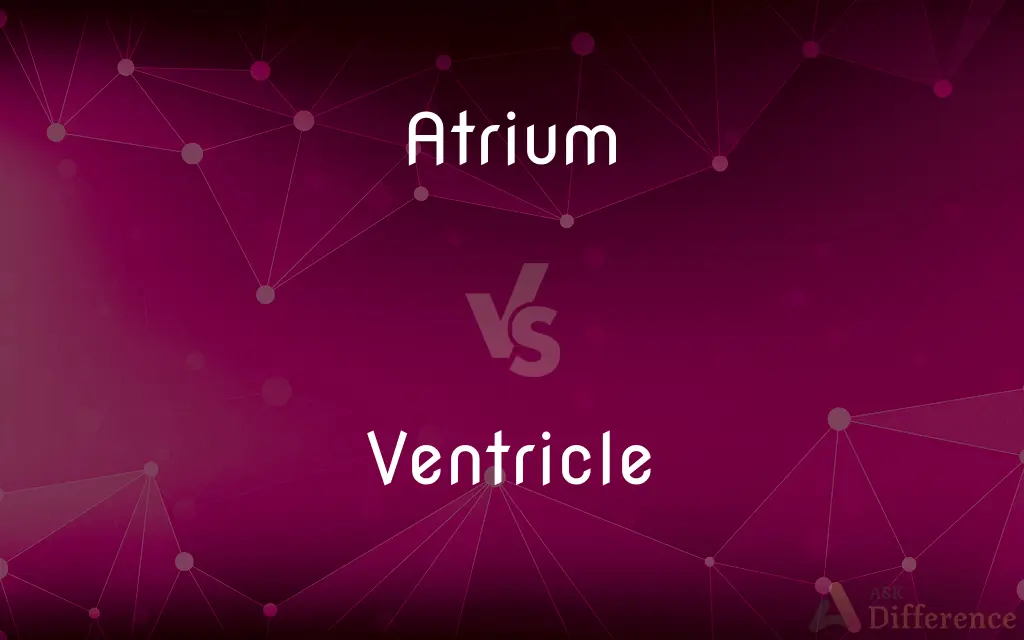Atrium vs. Ventricle — What's the Difference?
By Tayyaba Rehman & Maham Liaqat — Updated on March 31, 2024
An atrium is one of the two upper chambers in the heart that receives blood, while a ventricle is one of the two lower chambers that pump blood out. Atria collect blood, ventricles distribute it.

Difference Between Atrium and Ventricle
Table of Contents
ADVERTISEMENT
Key Differences
The atrium (plural: atria) is located in the upper part of the heart and plays a crucial role in receiving blood that comes into the heart from the body or lungs. It acts as a holding chamber, allowing blood to pool and be sent down to the ventricle. On the other hand, the ventricle is found in the lower part of the heart and is responsible for pumping blood out of the heart to the lungs and other parts of the body. This fundamental difference highlights the atria's role in collection and the ventricles' role in distribution.
Atria have thinner walls compared to ventricles, reflecting their different functions. The atria receive blood at lower pressure and require less force to move blood to the ventricles. Whereas, ventricles have thicker, more muscular walls to generate the high pressure needed to pump blood throughout the body or to the lungs. This structural difference is crucial for the heart’s ability to efficiently circulate blood.
In terms of electrical activity, the atrium is the first to receive the electrical signals that initiate the heartbeat. This causes the atria to contract and push blood into the ventricles. The ventricles then receive the signal, contract, and pump blood out of the heart. This sequential electrical activity ensures the coordinated pumping action of the heart, necessary for effective blood circulation.
Blood flow dynamics also differ between the two chambers. The atria fill with blood during heart relaxation (diastole), and then blood moves to the ventricles. Once the ventricles are filled, they contract during systole to pump blood out. This cycle emphasizes the atria's role in filling and the ventricles' role in pumping, integral to maintaining the heart's blood flow cycle.
Furthermore, the atria and ventricles are separated by valves to prevent the backflow of blood, ensuring that blood moves in one direction. The atrioventricular valves (tricuspid and mitral valves) lie between the atria and ventricles, highlighting their interconnected yet distinct functions within the heart's pumping system.
ADVERTISEMENT
Comparison Chart
Location
Upper chamber of the heart
Lower chamber of the heart
Wall Thickness
Thinner walls
Thicker, more muscular walls
Function
Receives blood from the body or lungs
Pumps blood to the body or lungs
Electrical Activity
First to receive electrical signals
Receives signals after the atria
Blood Flow
Fills with blood during diastole
Pumps blood out during systole
Compare with Definitions
Atrium
Upper heart chamber receiving blood.
The right atrium receives deoxygenated blood from the body.
Ventricle
Characterized by thick walls.
The ventricle's muscular walls enable powerful blood pumping.
Atrium
Initiates the heart's electrical signal.
The SA node in the atrium starts the heartbeat.
Ventricle
Contracts to pump blood out.
Ventricular contraction forces blood through the arteries.
Atrium
Collects blood for the ventricles.
Blood pools in the atrium before moving to the ventricle.
Ventricle
Pumps blood during heart contraction.
In systole, the ventricle expels blood to the systemic circulation.
Atrium
Has thinner walls.
The atrium's walls are thin to accommodate incoming blood at lower pressure.
Ventricle
Lower heart chamber that pumps blood.
The left ventricle pumps oxygenated blood to the body.
Atrium
Receives blood during heart relaxation.
During diastole, the atrium fills with blood from the lungs.
Ventricle
Distributes blood to lungs or body.
The right ventricle sends blood to the lungs for oxygenation.
Atrium
An open-roofed entrance hall or central court in an ancient Roman house.
Ventricle
The chamber on the left side of the heart that receives arterial blood from the left atrium and contracts to force it into the aorta.
Atrium
Each of the two upper cavities of the heart from which blood is passed to the ventricles. The right atrium receives deoxygenated blood from the veins of the body, the left atrium oxygenated blood from the pulmonary vein.
Ventricle
The chamber on the right side of the heart that receives venous blood from the right atrium and forces it into the pulmonary artery.
Atrium
A usually skylit central area, often containing plants, in some modern buildings, especially of a public or commercial nature.
Ventricle
Any of the interconnecting cavities of the brain.
Atrium
The open area in the center of an ancient Roman house.
Ventricle
Any small cavity within a body; a hollow part or organ, especially:
Atrium
The forecourt of a building, such as an early Christian church, enclosed on three or four sides with porticoes.
Ventricle
One of two lower chambers of the heart.
Atrium
(Anatomy) A body cavity or chamber, especially either of the upper chambers of the heart that receives blood from the veins and forces it into a ventricle. Also called auricle.
Ventricle
(neuroanatomy) One of four fluid-filled cavities in the brain, that are continuous with the central canal of the spinal cord.
Atrium
(architecture) A central room or space in ancient Roman homes, open to the sky in the middle; a similar space in other buildings.
Ventricle
(archaic) The stomach.
Atrium
(architecture) A square hall lit by daylight from above, into which rooms open at one or more levels.
Ventricle
(archaic) The womb.
Atrium
(anatomy) A cavity, entrance, or passage.
An atrium of the infundibula of the lungs
Ventricle
A cavity, or one of the cavities, of an organ, as of the larynx or the brain; specifically, the posterior chamber, or one of the two posterior chambers, of the heart, which receives the blood from the auricle and forces it out from the heart. See Heart.
Atrium
(biology) Any enclosed body cavity or chamber.
Ventricle
The stomach.
Whether I will or not, while I live, my heart beats, and my ventricle digests what is in it.
Atrium
(anatomy) An upper chamber of the heart that receives blood from the veins and forces it into a ventricle. In higher vertebrates, the right atrium receives blood from the superior vena cava and inferior vena cava, and the left atrium receives blood from the left and right pulmonary veins.
Ventricle
Fig.: Any cavity, or hollow place, in which any function may be conceived of as operating.
These [ideas] are begot on the ventricle of memory.
Atrium
(anatomy) A microscopic air sac within a pulmonary alveolus.
Ventricle
One of four connected cavities in the brain; is continuous with the central canal of the spinal cord and contains cerebrospinal fluid
Atrium
A square hall lighted from above, into which rooms open at one or more levels.
Ventricle
A chamber of the heart that receives blood from an atrium and pumps it to the arteries
Atrium
The main part of either auricle of the heart as distinct from the auricular appendix. Also, the whole articular portion of the heart.
Atrium
A cavity in ascidians into which the intestine and generative ducts open, and which also receives the water from the gills. See Ascidioidea.
Atrium
A cavity, entrance, or passage; as, the atrium, or atrial cavity, in the body wall of the amphioxus; an atrium of the infundibula of the lungs, etc.
Atrium
Any chamber that is connected to other chambers or passageways (especially one of the two upper chambers of the heart)
Atrium
The central area in a building; open to the sky
Common Curiosities
Why do atria have thinner walls than ventricles?
Atria have thinner walls because they deal with lower blood pressure compared to ventricles, which need thick walls to generate the high pressure required to pump blood.
Can the atrium pump blood to the body?
No, the atrium collects blood and transfers it to the ventricle, which then pumps it to the body or lungs.
What is the significance of ventricular thickness?
The thickness of the ventricular walls allows these chambers to generate the high pressure needed to pump blood effectively throughout the body or to the lungs.
How does the heart ensure coordinated contraction?
The heart's electrical system initiates signals that first cause the atria to contract, pushing blood into the ventricles, followed by ventricular contraction to pump blood out.
Why is the electrical activity of the heart important?
The heart's electrical activity ensures the timed and coordinated contraction of atria and ventricles, essential for efficient blood circulation.
Can atrial and ventricular health affect each other?
Yes, diseases or dysfunction in either the atria or ventricles can impact the overall functioning of the heart, affecting blood flow and pressure.
What separates the atrium from the ventricle?
Atrioventricular valves (tricuspid and mitral valves) separate the atrium and ventricle, preventing backflow of blood.
How does blood flow through the heart?
Blood flows into the atria from the body or lungs, then to the ventricles, which pump it back to the lungs or throughout the body.
How do atria and ventricles adapt to exercise?
During exercise, the heart rate increases, leading to faster atrial and ventricular contractions to meet the body's increased oxygen demand.
What happens if the ventricles do not function properly?
If ventricles fail to function properly, it can lead to inadequate blood circulation, affecting the oxygen and nutrient supply to the body.
How does the structure of atria and ventricles reflect their functions?
The structure of each chamber is tailored to its role: atria have thinner walls suitable for receiving blood, and ventricles have thick walls for pumping blood.
What is diastole and systole in relation to atria and ventricles?
Diastole is the phase when the heart relaxes, and the atria fill with blood; systole is when the heart contracts, and ventricles pump blood out.
What is the role of valves in atrial and ventricular function?
Valves ensure directional blood flow between atria and ventricles and prevent backflow, critical for the heart's pumping efficiency.
Share Your Discovery

Previous Comparison
Vacant vs. Worth
Next Comparison
Lanted vs. LandedAuthor Spotlight
Written by
Tayyaba RehmanTayyaba Rehman is a distinguished writer, currently serving as a primary contributor to askdifference.com. As a researcher in semantics and etymology, Tayyaba's passion for the complexity of languages and their distinctions has found a perfect home on the platform. Tayyaba delves into the intricacies of language, distinguishing between commonly confused words and phrases, thereby providing clarity for readers worldwide.
Co-written by
Maham Liaqat














































